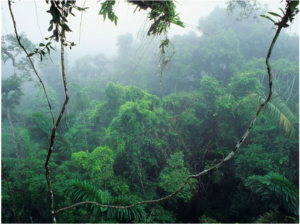Rainforests, like this one in Ecuador, only appeared after the mass extinction that ended the Age of Dinosaurs. Wolfgang Kaehler / LightRocket via Getty Images
No, Dinosaurs Did Not Trudge Through Thick Rainforests
Rainforests did not yet exist when the Tyrannosaurus and Triceratops roamed the Earth. None of the iconic “terrible lizards” that we so often associate with steaming, dense jungles lived in any such habitat. In fact, it was the destruction of the non-avian dinosaurs that allowed our planet’s first rainforests to form.
Despite depictions of dinosaurs peeking through palm fronds in films from Fantasia to Jurassic Park, paleobotanists have found that Earth’s earliest rainforests only sprung up in the wake of the terrible asteroid impact that ended the Cretaceous. The absence of big dinosaurs, as well as the proliferation of plants known as angiosperms—often called “flowering plants,” as they flower and bear fruit—finally allowed warm, humid forests to grow dense. What were once relatively open, dinosaur-trampled landscapes closed into thick forests where many more small species could evolve and take on new shapes, including our early primate ancestors.

Up until recently, tracking the history of Earth’s rainforests was complicated by a spotty fossil record. Some aspects of these landscapes’ natural history, such as acidic soils and leaves falling to the forest floor, where they decompose, had obscured their past. But in 2009, Smithsonian Tropical Research Institute paleobotanist Carlos Jaramillo and colleagues identified the earliest known neotropical rainforest in a coal mine situated in what’s now Colombia. Leaf and other plant fossils preserved in the roughly 58-million-year-old rock of the Cerrejón Formation revealed a landscape filled with palms, legumes and other plants often seen in rainforests today. More recent studies have even discovered the conditions necessary for the early rainforest to spring up—which were a consequence of both extinction and the adaptations of flowering plants.
The anatomical details of the plant fossils at the locality, as well as their variety, indicated that the Cerrejón’s ancient forest was very much like rainforests that grow in the tropics today. Paleobotanists recognized at least 65 different leaf shapes, mostly from angiosperm plants such as laurels, moonseeds, relatives of cacao and others, with very few conifers, which are technically known as gymnosperms. Most of the leaves were large and had smooth edges, traits associated with high temperatures and increased rainfall. Some leaves even had damage that indicated many different plant-eating insects lived in the forest, too. Taken all together, the fossils revealed a forest that couldn’t have existed before the asteroid impact.
“If you really think about it, can you imagine something as big as a T. rex, a Stegosaurus, or even a giant sauropod traipsing through a rainforest?” says University of Wyoming paleobotanist Ellen Currano. A moment’s thought underscores how silly the trope is: Just imagine multi-ton animals threading through clusters of close-growing trunks. Big dinosaurs altered the landscapes they lived on, so they are part of why the earliest rainforests didn’t show up until after they vanished.
Back during the time of the duck-billed dinosaur Edmontosaurus, around 66 million years ago, the world was brimming with huge, herbivorous dinosaurs. The ever-hungry plant eaters not only munched on leaves, branches and even rotting logs, but they also trampled vegetation underfoot and left dinosaur-sized gaps in forests where conifer trees were still very prominent. Edmontosaurus and similar dinosaurs were what ecologists refer to as megaherbivores, and just like elephants, rhinos and giraffes in Africa today, the big herbivores maintained a relatively open landscape by where they walked and what they ate. Forests where big dinosaurs roamed simply couldn’t grow very dense, meaning that such forests did not have the closed canopies so often associated with rainforests.
Had the asteroid missed or the impact played out differently, rainforests as we know them may never have existed. “Had there not been that impact, we might still have gymnosperms, and non-avian dinosaurs for that matter, as prevalent groups today,” Currano says.
When the only dinosaurs left were small birds, however, ecosystems could grow in new ways. Relatives of conifers, Jaramillo says, were the most common tall-growing trees when T. rex was alive. “As the extinction wiped out all these trees, angiosperms had a higher chance of survival,” he notes.
The surviving angiosperms got a boost from changes to the soil. The impact pulverized a great deal of rock and spread the mineral-rich dust all over the planet, including iron that enriched the soil. The evolution and spread of legumes, too, increased nitrogen levels in soils and favored the spread of angiosperms. “We had a brand-new soil with abundant iron and nitrogen, the perfect setting for angiosperms to grow,” Jaramillo says. Given that angiosperms grow faster than conifer relatives, the plants were able to form canopies that cast shade on the ground below and suppressed the ability of other plants to grow.
Taken together, the climate conditions and effects of Earth’s fifth mass extinction allowed forests to grow thick. Even places as far from the Equator as prehistoric Colorado began to host rainforests where birds, mammals, insects and other creatures could thrive. The new growth influenced the evolution of creatures that survived the mass extinction. Mammals, including our early primate ancestors, were undoubtedly shaped by the shift.
In a more open landscape like the sort big dinosaurs inadvertently created, mammals had a relatively limited number of ways to make a living. They could burrow under the surface of the soil, run on top of it, climb trees or evolve to live along the water’s edge. But thick forests offered new possibilities, such as the ability to jump from tree to tree or live a life among the branches without ever touching the ground. Coexistence and competition also drove what ecologists call niche partitioning, where similar animals evolve different behaviors, food preferences and ways of living in order to live side by side. “The complex structure of rainforests created more habitats, or niches, for organisms to diversify,” Currano says. The spread of rainforests opened a greater array of possibilities that ramped up biodiversity compared to the more open, dinosaur-influenced forests of the Cretaceous.
“Having a closed-canopy angiosperm rainforest was a boost for biodiversity, not only because of the structure of the forest but because angiosperms have a wider range of variations,” Jaramillo says. A global shake-up gave an accidental advantage to angiosperms, which then began reshaping the planet in a way never seen before. The rich array of species we associate with rainforests today is an echo of those first Paleocene forests, which were a haven of biodiversity that could have only sprung up after extinction.



